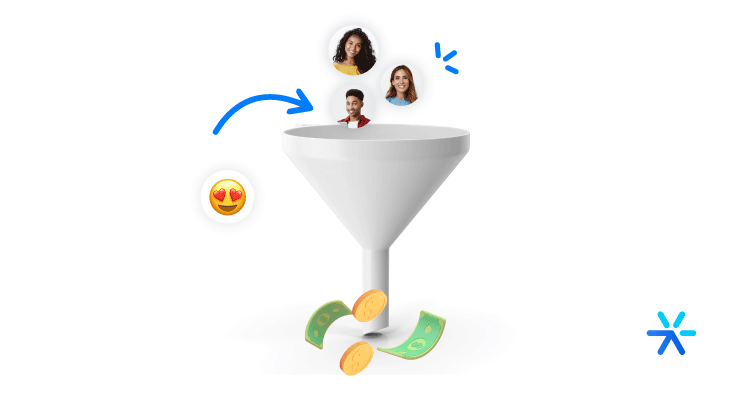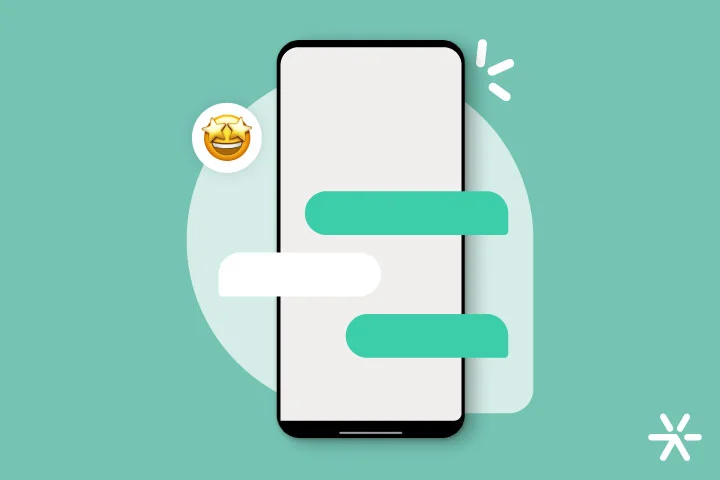How to Generate Sales Leads and Convert Them Faster
In any inbound marketing strategy, generating sales leads is one of the main objectives. “One of the main” because the ultimate goal is always to sell.
There’s only one way to start on this sales path: aim to sell to qualified contacts, with some interaction with your brand, and who have needs compatible with your service. That’s the definition of a good lead.
In most companies that struggle to implement this strategy, the biggest problem is always the lack of communication between the team that generates leads and the team that closes sales.
This article will delve a bit deeper into this and provide practical solutions that you can implement with one or two meetings, even this week.
Shall we learn more?
What are Sales Leads?

The definition of sales leads is simple: they are contacts that your company has that are minimally identified. In other words, your company has:
- The lead’s name;
- Their contact information;
- The segment they operate in;
- A demonstrated interest in something your company offers.
These are the four basic points that constitute a qualified lead. The last point, the demonstrated interest, often gets ignored by many companies, which is a serious problem.
Demonstrated interest is indicated by the type of conversion your sales lead had. For example, if they downloaded an e-book about “Concrete manhole thicknesses for drainage,” your company knows the lead is interested in acquiring concrete manholes.
Not paying attention to this interest causes problems. For instance, you might have a database of a thousand leads, and all of them are interested in services you no longer offer. This makes selling more difficult.
But we’re getting ahead of ourselves. Let’s see what types of leads there are so we can delve deeper into this conversation:
What are Top of Funnel Leads?
You have a website, and this website has a blog. One day, you write a very good article, full of references and high expertise. None of your competitors have anything similar published.
Overnight, your article starts bringing thousands of visitors to your site. And at the end of this article, a simple banner directs your leads to extra, free material that they can download, which has even more content than your article.
This is a top of funnel lead, the most common type of sales lead. A company that invests well in lead generation typically has a list of around 3,000 to 10,000 leads like this.
It may seem like a lot, but the truth is that top of funnel leads are difficult to convert into sales. They have this name, top of funnel, because they are literally at the beginning of the conversion funnel.
Every company that works with digital marketing and inbound marketing needs to continually generate top of funnel leads. This is because through them, you will form another category:
What are Qualified Leads?
Qualified leads are leads that are more likely to buy from you or close a contract for various reasons. They are also the sales leads with the right profile that you are looking to sell to.
Let’s suppose, in this example, that out of the 300 leads you generated in a month, 70 of them had these key characteristics:
- They have the revenue that your company is aiming to achieve;
- They usually buy from your competition;
- They may have all their needs met by you;
- They are from a region you serve/deliver to;
- They show interest in more commercial material, bottom of the funnel;
This is a qualified lead: one that presents the qualities that your company sees as a fit, someone ready to buy from you, and who has already taken the first step on their own.
Speaking like this, it might seem like your company is being choosy about customers. But in digital marketing, especially with the inbound methodology, that’s how it goes.
You will have thousands of top of funnel leads precisely to create a filter that will only deliver the best sales leads, those who will buy more with less effort from your sales team.
What are Opportunity Leads?
These are the leads you have when you do lead nurturing, a process of continually staying in touch with your qualified leads primarily through email marketing.
Opportunity leads are those who, during your lead nurturing work, crossed a parameter that you determine during your marketing automation and are ready to close the sale.
These parameters are defined by you. Perhaps the lead answered a questionnaire, downloaded a sales presentation, attended an in-person lecture they were invited to – it all depends on your strategy.
When the lead reaches this stage, it’s time to stop everything and sell now.
What Do I Need to Generate Sales Leads?

Okay, we refreshed our memory in the previous section, and you are already 100% clear about what sales leads are, right?
So let’s talk now about how to generate these sales leads. Where do they come from? Where do they demonstrate their interest in your products and services? How do you actually convert them?
To start generating your first sales leads, you will need to have some technological resources. The main ones are:
You need to have a website
It is through your website that sales leads will emerge. Without one, you won’t be able to produce standardized content enough to generate leads in a safe, scalable, and practical way.
Websites are not that complicated to develop. Alone, in a few months, you can build a website using WordPress or Wix without much hassle.
But we recommend that you look for a digital marketing agency specialized in this work. They can provide you, in addition to the website, a series of other services, such as:
- Standardization of your visual identity;
- All Google Analytics and Search Console settings;
- Creation of profiles for publication on the site;
- Creation of all text on the site;
- And, of course, the website itself. The investment will not be very high, and the delivery is much faster than learning to do everything yourself.
You will need a landing page
A landing page is a destination page. Remember our example at the beginning of the article, about the material at the end of an article that brought many visits to your site?
For people to leave their information and download this material, you will need to create a landing page.
There are several platforms that offer the creation of landing pages. At the end of the article, we’ve listed some of the most popular ones. It’s worth checking them out!
You need to list and organize sales leads
Once you have sales leads exceeding the first hundreds, the need for a platform that organizes these leads arises. You can’t do much with a spreadsheet and a lot of goodwill, no matter how hard you try.
Marketing automation platforms can organize leads based on variables you define. For example, you determined that your qualified lead has the following characteristics:
- They have a company with more than 10 employees and fewer than 50;
- They specifically downloaded one of the more commercial e-books;
- They are from your region.
A sales lead management platform will automatically put them on the qualified leads list, saving you time and effort, and never making mistakes.
You need to communicate with sales leads
With leads in hand, you need to guide them through the sales funnel. And this is only possible with lead nurturing, usually done through marketing automation focused on email.
Email indeed. Today it is one of the main conversion tools in digital marketing.
The main platforms in the market today can capture leads through landing pages, organize them with personalized filters, and also offer support for automated email sending.
How to Start Generating Sales Leads?

We’re making good progress! We’ve defined the types of sales leads and what you need to have to generate them. Now let’s focus on how.
Just a heads-up: this work is specialized and collaborative. Generating sales leads, to be successful, needs to take into account the characteristics of your business and the ideal customer profile.
But even though it’s specialized work, generating sales leads always starts from the same premise: you need to offer something that your potential customer wants. That’s the only reason that will make them hand over their registration information.
Here’s a quick list of examples of how to generate sales leads:
- Promotions: by far, one of the best ways to convert leads is by offering discounts. Identify your most accessed pages (this can be done through Google Analytics) and put up a simple banner: “10% off for those who register.” There you go: you’re generating sales leads;
- Good segmented content and free materials: write content focused on all the areas your customers work in. Work in law? Write texts for all your specialties. And in each of these texts, offer more in-depth material that your reader can read if they register;
- Loyalty programs: you are already familiar with this modality, right? Nowadays, practically all retail segments already work with loyalty programs in some way. To generate leads like this, you can create a Club: those who register receive exclusive offers every month;
- Newsletter: if you generate a lot of traffic via blog, YouTube, or Social Media? Foster your audience by offering a Newsletter for those who leave their email. The Newsletter is a recurring email talking about the newest content released on your communication channels.
You can set one of these actions in motion or all of them at the same time. It all depends on your willingness to generate more and more sales leads.
The good thing about these actions is that many of them only need to be conceived and applied once. Leads will be generated automatically every day.
How to Convert Leads into Sales?

Most of the steps above are applied by most companies today. It’s quite challenging to find one that works in digital marketing and isn’t generating leads.
But the hallmark of successful companies is the conversion of these leads into sales. This part is fundamental in the strategy and is what will validate all your efforts in digital marketing.
Every company has its reality. Here are five more common actions in lead conversion to inspire you. Let’s find out?
Lead Nurturing
We touched on this topic throughout the article, but it’s worth delving deeper into sales lead nurturing.
The distance between a visitor who just turned into a sales lead and the sale can be quite significant. For them to get there, a lot of work is needed – lead nurturing itself.
This is done through a series of actions, but initially, mainly through email. It’s difficult to keep an audience engaged in emails, but it’s also a task you do once per flow. The rest is all automated.
With a marketing automation tool, you can create a communication sequence. In it, you define which emails your lead will receive in which situation.
For example:
- Visitor became a sales lead: send an email inviting them to join the Newsletter;
- Lead clicked on the buttons of three newsletters: send an email with exclusive free materials;
- Lead downloaded all materials: send an email with a sales presentation;
- Lead read the sales presentation: it’s time to move away from email and go personal.
And how do you move away from email? How do you go to the final stages of the sale?
Actions Closer to Closing the Sale
Okay, so you’ve done all this nurturing work. Remember the types of sales leads? That lead that accompanied you throughout this process – that was nurtured – is now a sales opportunity.
This is where the sale will happen. After this entire process – which is worth repeating, is automated – your sales team goes into the field to close.
Just a note before talking about specific actions: everything we’ve talked about so far is not just marketing’s responsibility. It’s the responsibility of the whole company, with enormous support from the sales area.
At this point, the sales area will take the lead and close the sale. And this closing will be much easier because the lead is already highly qualified, already knows the company and the services you offer.
See actions for finalization:
Scheduling Meetings
When the lead reaches this stage, it’s time to start sending emails trying to schedule a meeting.
This is done a lot via email, but the strategy and wording need to be very good to not scare off your lead right now, at the time of final contact.
For example: I receive many emails with the subject “CONFIRMED SCHEDULE,” as if the meeting had already been scheduled. It’s a bit invasive, don’t you think?
The email needs to be more sober and developed together with your sales team. They will know what works when talking to customers in your segment.
Calls
What we’re going to do now is the opposite of cold calling – that strategy of calling several numbers to see if any of them close a sale.
When the sales lead reaches this stage, the phone call needs to be highly personalized.
Marketing automation platforms allow you to understand exactly how the lead interacted with your brand – which content they downloaded, in which texts they found this rich material, which materials they received via email, and so on.
This information is great for building rapport with your lead. It’s time to call and say, “look, I see here that your company works with X and you need help with Y and Z. We can help you with that.”
How to Manage Sales Leads?

There are some platforms that take care of managing sales leads in your company. All of them will help you a lot in your work.
As we mentioned earlier, it’s practically impossible to have a few hundred leads and keep all the organization in a spreadsheet. There’s too much information, and each mistake can have a direct effect on sales.
Here are some resources that will help you a lot:
19 tools for lead management and marketing automation
There are several tools for managing leads in your company. Each one will have several particularities.
The summarized list is here:
- RD Station;
- LAHAR;
- ActiveCampaign;
- E-goi;
- MailBiz;
- Sharpspring;
- Hubspot;
- Mailchimp;
- LeadLovers;
- Snov.io;
- Salesforce Pardot;
- Sendinblue;
- SendPulse;
- Infusionsoft;
- Dinamize;
- Fleeg;
- Mautic;
- Marketo;
- Oracle Eloqua.
All Set to Generate Sales Leads?
You’ve just gone through all the stages of generating sales leads. Now you’re ready to start your work.
There was just one point we didn’t address here: us. Are you already familiar with Leadster?
Our platform allows for much higher conversion across your site. Instead of putting up banners and CTAs everywhere, you only need a personalized call that prompts your visitor to take action and convert.
I invite you to try our tool for 14 days for free. Just visit the site through this link and click on “see demo.” You’ll notice that even during the adaptation period, your sales lead generation will take a huge leap.







